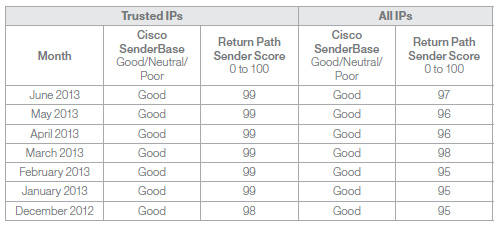According to Return Paths Email Intelligence Report Q4 2012, 18% of permission-based email in North America never reaches the inbox: 5% is classified as spam, and the remaining 13% simply goes missing. While 82% inbox placement is not a horrible number, marketers would agree that there is certainly room for improvement.
Your reputation as a sender is crucial. Email deliverability is more and more about your reputation as a sender and less about the actual content of your emails. This does not mean that content is not important, but it does mean that marketers need to give plenty of attention to how their email campaigns are being delivered. When it comes to modern email delivery, its good to know the fundamentals. If you want to learn more about email deliverability, download our brand new ebook.
Be sure to follow this proactive checklist to give your emails the best chance of hitting the inbox:
1. Follow the trust and engagement mantra.
Give your subscribers a good reason to opt in and set clear expectations about whats to come. Then, follow through on your promises with timely, targeted, valuable email marketing.
2. Use responsible methods to build your lists.
Verify all new email addresses before sending your messages, and regularly scrub your contact lists to remove inactive addresses.
3. Choose a solid email marketing platform.
Make sure the vendor you choose is sophisticated enough to handle bounce codes, feedback loops, and connection optimization.
4. Create engaging content.
On its own, bad content wont prevent your emails from being delivered, but if your content is boring or irrelevant, people wont engage with it or, worse, will mark your emails as spam.
5. Manage your complaint rate.
If your email marketing service warns you that complaints made against you are high, take the warning seriously. Set up an email address [email protected] that a representative of your email marketing service or an anti-spam organization can use to contact you with any complaints. Register that email address with www.abuse.net, an anti-spam advocacy group and resource center, to show anti-spam organizations that you are responsible and that youve given thought to the email abuse issue.
6. Be proactive about closely monitoring your reputation metrics.
Get your email reputation score to learn what you need to change about your program in order to improve your reputation and your inbox placement rates. Return Path, a leader in email intelligence, offers a product called Sender Score, which, in addition to providing you with your reputation score, shows you how your email marketing program stacks up against your competitors. Sender Scores proprietary algorithm ranks a sending IP address on a scale of 0 to 100, where 0 is the worst score and 100 is the best. Ranking is based on factors such as complaints against you, volume of your emails, your external reputation, number of unknown users, and amount of rejected emails. Another reputation monitoring option is SenderBase. Part of the Cisco IronPort SenderBase Security Network, SenderBase rates your IP as good (little-to-no threat activity), neutral (within acceptable parameters), or poor (showing a problematic level of threat activity).

7. Be transparent.
Let your subscribers and potential subscribers know how youre doing when it comes to complaint rates, bounces rates, and your Sender Score rank. To see how Marketo presents this data, to give our clients confidence that their emails are getting delivered, see Marketos Trust page.
What are you doing to ensure email deliverability? To find out more information download our new ebook Email Deliverability.
SOURCE: http://bit.ly/1faqLbE, this factual content has not been modified from the source. This content is syndicated news that can be used for your research, and we hope that it can help your productivity. This content is strictly for educational purposes and is not made for any kind of commercial purposes of this blog.